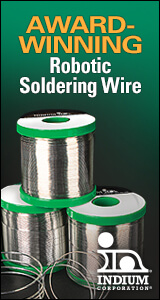|

|
|
| Ask the Experts | |||||||
|
|||||||
|
July 26, 2010 - Updated July 26, 2010 - Originally Posted SPC for Reflow OvensWhat is the best way of running SPC on a reflow oven? K. F. |
|||||||
| Expert Panel Responses | |||||||
|
What most people mean when they ask, "what is the best way of running SPC" on most any process is, "what is the most practical way?" This is because SPC math demands a lot from a process. In fact many SPC tools, like GR&R, cannot be done for a reflow solder thermal process. This is because the GR&R study demands you measure the same "part" more than once. People assume this means you run the reflow solder profile a second time, which does NOT measure the same part a second time, it produces a second and completely new part, which is not the same as measuring the same part two times. See more discussion on this in my blog. SPC also demands a lot of data, and even the simplest profiling tools take a little time and discipline to perform. So there is often too little data to allow SPC to really work correctly. However, corporations willing to take the time to get the needed data from their reflow process will gain much in improved process control, proof that your oven is in control, increased yields, reduced scrap, as well as a marketable differentiator over your competition, in that it shows that you are concerned about your thermal processes. The most practical way to collect data about your reflow oven, and thus begin to produce meaningful process SPC, is via tools which are designed to measure your oven's capability at a given recipe (oven settings). These tools have the advantage of remaining stable over many 1000s of uses and thus allow you to see how your oven is performing over time. Unlike the original circuit board, which was used to develop the oven recipe, these tools can confirm that the oven is repeating the same thermal environment long into the future. They can be use to check if your oven is ready to run at a production recipe at each shift change, every day, after each recipe change, etc, and at the same time capture valuable data which can be used to produce the SPC control and capability charts for the reflow oven. There are several of these tools to choose from, like the OvenRIDER by ECD. Much more information than can be included here can be found in my blog on this very question of SPC for reflow ovens (Oven Verification) using an OvenRIDER. Please feel free to take a look.
Senior Project Engineer Electronic Controls Design Inc Paul been with Electronic Controls Design Inc. (ECD) in Milwaukie, Oregon for over 39 years as a Senior Project Engineer. He has seen and worked with the electronic manufacturing industry from many points of view, including: technician, engineer, manufacture, and customer. His focus has been the design and application of measurement tools used to improve manufacturing thermal processes and well as moisture sensitive component storage solutions.
The first question to decide upon is whether you want to run SPC on the machine itself (reflow oven) or on the process. The reflow oven will constantly change in order to maintain a stable process. The oven is trying to compensate for variances in load, ambient temperature, preventive maintenance, wear and tear, flux build up, and much more. It therefore makes more sense to run SPC on the process itself (profile), which is really what determines your production quality. There are a few accepted methods to run SPC on the process.
President inspīre solutions LLC Bjorn Dahle is the President of inspīre solutions LLC. He has 20 years experience in the electronic manufacturing industry with various manufacturing equipment companies covering pick & place, screen printers and thermal process management.
One of the easiest ways of running SPC on a reflow oven is to use our ECD's OvenRIDER, whereby the product software automatically capture the necessary data and plot the SPC chart. You just need to run the OvenRIDER through the reflow oven at a same recipe over a desired number of cycles.
Managing Director, Asia Pacific ECD EH Lim has been in the PCB Assy industry since 1985, starting at Thomson/Singapore for 5 years before moving to Electrovert Asia Pacifc. Lim was Sales Director for Vitronics Soltec prior to joining ECD in 2007 as Managing Director for Asia Pacific.
|
|||||||
| Submit A Comment | |||||||
|
Comments are reviewed prior to posting. You must include your full name to have your comments posted. We will not post your email address. |
|
Free Newsletter Subscription
Circuitnet is built for professionals who bear the responsibility of looking ahead, imagining the future, and preparing for it. Insert Your Email Address |
|

|





